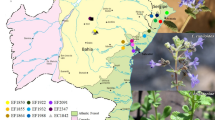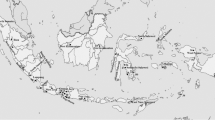Abstract
The pinewood nematode Bursaphelenchus xylophilus is the causal agent of pine wilt disease. In order to trace the origin of its recently introduced Portuguese population, two PCR-based techniques, random amplified polymorphic DNA (RAPD) and inter-simple sequence repeats (ISSR), were used to determine genetic relationships among 30 B. xylophilus isolates from the Usa, Canada, Japan, China, South Korea and Portugal. Fingerprints obtained with both methods detected a reduced genetic variation of introduced popula- tions as compared to native North American populations. Cluster analyses of genetic distances between isolates were carried out and bootstrap dendrograms were constructed. The results indicated that founders of the Portuguese popula- tions most likely were translocated one or two times to Portugal from their colonized sites in East Asia, but not from their native habitats in North America.
Zusammenfassung
Der Kiefernholznematode Bursaphelenchus xylophilus ist für die sogenannte Kiefernwelke verantwortlich. Um die Herkunft der eingeschleppten portugiesischen Population zu bestimmen, wurden die genetischen Unterschiede von 30 B. xylophilus’-Herkünften aus den USA, Kanada, Japan, China, Südkorea und Portugal mit 2 PCR-basierten Techniken, RAPD (random amplified polymorphic DNA) und ISSR (inter-simple sequence repeats) untersucht. Die erhaltenen Fingerprints der Herkünfte zeigten mit beiden Methoden eine reduzierte Anzahl von potenziellen Markern für Isolate aus Einschleppungsgebieten im Vergleich zu Isolaten aus dem Ursprungsvorkommen in Nordamerika. Clusteranalysen der genetischen Distanzen der Herkünfte wurden ausgeführt und Dendro- gramme konstruiert. Die Ergebnisse weisen darauf hin, dass sich das portugiesische Vorkommen aus ein- bis zwei Einschleppungen von Tieren aus Ostasien etabliert haben kann. Es gründet sich demnach nicht auf Tiere aus Nordamerika.
Similar content being viewed by others
Literature
Abbot, P., 2001: Individual and population Variation in inver- tebrates revealed by inter-simple sequence repeats (ISSRS). 3 pp. J. Insect Sci., 1.8. Available online: insectscience.org/1.8.
Braasch, H., W. Burgermeister, K.H. Pastrik, 1995: Differentiation of three Bursaphelenchus species by means of RAPD-PCR. Nachrichtenbl. Deut. Pflanzenschutzd. 47, 310–314.
Caswell-Chen, E.P., V.M. Williamson, F.F. Wu, 1992: DNA analysis of Heterodera cruciferae and Heterodera schachtii populations. J. Nematol. 24, 343–351.
Evans, H.F., D.G. McNamara, H. Braasch, J. Chadoeuf, C. Magnusson, 1996: Pest Risk Analysis (Pra) for the territories of the European Union (as Pra area) on Bursaphelenchus xylophilus and its vectors in the genus Monochamus. European and Mediteranean Plant Protection Organisation, OEPP/EPPO Bull. 26, 99–
Hood, G.M., 2005: PopTools version 2.6.6. www.cse.csiro.au/poptools.
Irdani, T., A. Marinari, P. Bogani, L. Ambrogioni, S. Caroppo, M. Buiatti, 1995: Molecular diversity among pine wood Bursaphelenchus populations detected by RAPD analysis. Redia 78, 149–161.
Kiyohara, T., Y. Tokushige, 1971: [Inoculation experiments of a nematode, Bursaphelenchus sp., onto pine trees.] J. Jpn. For. Soc. 53, 210–218.
Kostia, S., M. Ruohonen-Lehto, R. Väinölä, S.L. Varvio, 2000: Phylogenetic information in inter-SINE and inter-SSR fingerprints of the Artiodactyla and evolution of the Bov-tA SINE. Heredity 84, 37–45.
Mamiya, Y., N. Enda, 1979: Bursaphelenchus mucronatus n. sp. (Nematoda, Aphelenchoididae) from pine wood and its biology and pathogenicity to pine trees. Nematologica 25, 353–361.
Mantel, N., 1967: The detection of disease clustering and generalized regression approach. Cancer Res. 27, 209–220.
Metge, K., W. Bürgermeister, 2005: Molecular identification and pathway analysis of the introduced pinewood nematode Bursaphelenchus xylophilus. In D.V. Alford, G.F. Backhaus (eds.): Plant Protection and Plant Health in Europe: Introduction and Spread of Invasive Species. Bcpc Symp. Proc. 81, 259–260.
Metge, K., T. Schröder, W. Bürgermeister, 2004: Biogeographische untersuchungen zur Herkunft des nach Europa eingeschleppten Kiefernholznematoden Bursaphelenchus xylophilus (Nematoda: Aphelenchoididae). Mitt. Biol. Bundesanst. 396, 296–297.
Mota, M.M., H. Braasch, M.A. Bravo, A.C. Penas, W. Bürgermeister, K. Metge, E. Sousa, 1999: First report of Bursaphelenchus xylophilus in Portugal and in Europe. Nematology 1, 727–734.
Nei, M., W.H. Li, 1979: Mathematical model for studying genetic variation in terms of restriction endonucleases. Proc. Nat. Acad. Sci. USA 76, 5269–5273.
Nickle, W.R., 1970: Taxonomic review of the genera Aphelenchoidea (Fuchs,1937) Thorne, 1949 (Nematoda — Tylenchida). J. Nematol. 2, 375–392.
Pfeilstetter, E., 2003: Monitoring invasiver Arten vor dem Hintergrund pflanzengesundheitlicher Regelungen [Monitoring of invasive species in relation to phytosanitary regulations]. Schriftenr. Bmvel A Angew. Wiss. 498, 233–237.
Reddy, K.D., J. Nagaraju, E.G. Abraham, 1999: Genetic characterization of the silkworm Bombyx mori by simple sequence repeat (Ssr)-anchored PCR. Heredity 83, 681–687.
Reddy, P., N. Sarla, E.A. Siddiq, 2002: Inter simple sequence repeat (ISSR) polymorphism and its application in plant breeding. Euphytica 128, 9–17.
Ruhm, W., 1956: Die Nematoden der Ipiden. Parasitol. Schriftenr. Jena 6, 1–437.
Saitou, N., M. Nei, 1987: The Neighbor-joining method: a new method for reconstructing phylogenetic trees. Mol. Biol. Evol. 4, 406–425.
Sakai, A.K., F.W. Allendorf, J.S. Holt, D.M. Lodge, J. Molofsky, K.A. With, S. Baughman, R.J. Cabin, J.E. Cohen, N.C. Ellstrand, D.E. Mccauley, P. O’neil, J.M. Parker, J.N. Thompson, S.G. Weller, 2001: The population biology of invasive species. Annu. Rev. Ecol. Syst. 32, 305–332.
Schmitz, B., W. Bürgermeister, H. Braasch, 1998: Molecular genetic classification of Central European Meloidogyne chitwoodi and M. fallax populations. Nachrichtenbl. Deut. Pflanzenschutzd. 50, 310–317.
Sneath, P.H.A., R.R. Sokal, 1973: Numerical Taxonomy: The principles and Practice of Numerical Classification. W.H. Freeman and Company, San Francisco, CA, USA.
Snell, T.L., M.A. Coffroth, 1999: Use of intersimple sequence repeats in analyzing intra and interspecific variability in scleractinian corals. Am. Zool. 39, 122A.
Sousa, E., M.A. Bravo, J. Pires, P. Naves, A.C. Penas, L. Bonifacio, M.M. Mota, 2001: Bursaphelenchus xylophilus (Nematoda; Aphelenchoididae) associated with Monochamus galloprovincialis (Coleoptera; Cerambycidae) in Portugal. Nematology 3, 89–91.
Steiner, G., E.M. Buhrer, 1934: Aphelenchoides xylophilus n. sp., a nematode associated with blue-strain and other fungi in timber. J. Agric. Res. 48, 949–951.
Swofford, D.L., 1998: Phylogenetic Analysis Using Parsimony (*and other methods). Version 4. Sinauer Associates, Sunderland, MA, USA.
Sylvester, H.A., 2003: Inter-simple sequence repeat-restriction fragment length polymorphisms for DNA fingerprinting. Biotechniques 34, 942–944.
Tomiczek, C., H. Braasch, W. Bürgermeister, K. Metge, U. Hoyer, M. Bandstetter, 2003: Identification of Bursaphelenchus spp. isolated from Chinese packaging wood imported to Austria. Nematology 5, 573–581.
Welsh, J., M. McClelland, 1990: Fingerprinting genomes using PCR with arbitrary primers. Nucleic Acids Res. 18, 7213–7218.
Williams, J.G.K., A.R. Kubelik, K.J. Livak, J.A. Rafalski, S.V. Tingey, 1990: DNA polymorphisms amplified by arbitrary primers are useful as genetic markers. Nucleic Acids Res. 18, 6531–6535.
Zietkiewicz, E., A. Rafalski, D. Labuda, 1994: Genome fingerprinting by simple sequence repeat (SSR)-anchored polymerase chain reaction amplification. Genomics 20, 176–183.
Author information
Authors and Affiliations
Corresponding author
Rights and permissions
About this article
Cite this article
Metge, K., Bürgermeister, W. Intraspecific Variation in isolates of Bursaphelenchus xylophilus (Nematoda: Aphelenchoididae) revealed by ISSR and RAPD fingerprints. J Plant Dis Prot 113, 275–282 (2006). https://doi.org/10.1007/BF03356193
Received:
Accepted:
Published:
Issue Date:
DOI: https://doi.org/10.1007/BF03356193
Key words
- genetic variation
- inter simple sequence repeat
- invasive alien species
- pathway of introduction
- pinewood nematode
- random amplified polymorphic DNA




